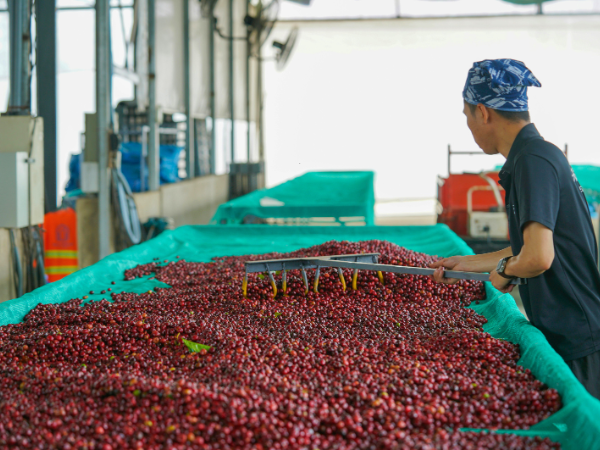Behind every great cup of coffee lies a journey that begins long before brewing — it starts at the processing stage. The way coffee beans are treated after harvest plays a crucial role in shaping their flavor, body, and aroma.
In this guide, we’ll explore the three most common processing methods — washed, natural, and honey — and how each one brings out distinct characteristics in your cup.
Coffee Processing Methods
Exploring coffee processing methods reveals how coffee beans transform from cherry to cup. The way beans are processed affects flavor, aroma, and overall quality. Understanding these methods helps you choose the right coffee for your taste.
Coffee processing methods are crucial steps in coffee production. Each method impacts the final taste. Here are the three main processing methods:
- Washed Process: Also known as the wet process. It involves removing the cherry’s outer skin and pulp. Beans are fermented and washed with water.
- Natural Process: This method leaves the cherries intact to dry in the sun. The beans absorb flavors from the fruit.
- Honey Process: A mix of both methods. The outer skin is removed, but some pulp remains. This adds sweetness and complexity.
Washed Process
The washed process produces clean and bright flavors. Here’s how it works:
- Harvest ripe coffee cherries.
- Remove the outer skin and pulp.
- Ferment the beans in water for several hours.
- Wash the beans to remove any remaining mucilage.
- Dry the beans in the sun or with machines.
This method highlights the bean’s natural characteristics. It is popular in regions like Colombia and Ethiopia.
Natural Process
The natural process is simple and traditional. Here’s what happens:
- Harvest ripe cherries.
- Spread them out to dry in the sun.
- Turn them regularly to prevent mold.
- Once dried, remove the dried fruit before milling.
This method can create fruity and wine-like flavors. It is common in Brazil and Yemen.
Honey Process
The honey process combines elements from both methods. Here’s how it works:
- Harvest cherries.
- Remove the outer skin but leave some pulp.
- Dry the beans with the pulp on them.
- The result is a sweet and complex flavor profile.
This method is gaining popularity in Costa Rica and Honduras.
| Processing Method | Key Features | Flavor Profile |
|---|---|---|
| Washed | Clean, fermented | Bright, crisp |
| Natural | Sun-dried, fruity | Sweet, wine-like |
| Honey | Partially processed | Complex, sweet |
Each processing method offers unique flavors. Experimenting with these can enhance your coffee experience.

Washed Processing
Coffee processing methods play a vital role in determining the flavor, aroma, and overall quality of the coffee we drink. Among these methods, washed processing stands out for its clarity and brightness. This method involves removing the fruit from the coffee cherry before fermentation.
Step-by-step Process
The washed processing method involves several critical steps. Each step ensures that the coffee beans develop their unique flavors. Here’s how it works:
- Harvesting: Ripe coffee cherries are picked from the coffee trees.
- Depulping: The outer skin and pulp of the cherries are removed, leaving the beans covered in mucilage.
- Fermentation: The beans are placed in water tanks. Fermentation lasts 12 to 72 hours. This process breaks down the mucilage.
- Washing: After fermentation, the beans are washed thoroughly to remove any remaining mucilage.
- Drying: The washed beans are spread out in the sun or dried in machines. This step reduces moisture content.
- Hulling: Once dried, the outer parchment layer is removed. This leaves the green coffee beans ready for roasting.
This method requires careful attention at each step. Proper execution ensures high-quality coffee beans with distinct flavors.
Flavor Profile
The flavor profile of washed coffee is known for its clarity and brightness. The removal of mucilage allows the true essence of the bean to shine. Here are some key characteristics:
- Brightness: Washed coffees often have a vibrant acidity.
- Cleanliness: The flavors tend to be crisp and clean.
- Floral Notes: Many washed coffees exhibit floral aromas.
- Fruity Flavors: Citrus and stone fruits are common tasting notes.
Due to its processing, washed coffee can sometimes lack the heavy body found in natural coffees. This makes it a favorite for those who enjoy a lighter brew. The balanced acidity and sweetness create a refreshing experience.
Benefits And Drawbacks
Washed processing comes with its own set of benefits and drawbacks. Understanding these can help coffee drinkers make informed choices.
| Benefits | Drawbacks |
|---|---|
| Highlights unique flavors of the coffee bean. | Requires more water, which can be environmentally taxing. |
| Produces a clean and bright cup. | Can lack the complexity found in naturally processed coffees. |
| Reduces the risk of defects in flavor. | Longer processing time may lead to inconsistencies. |
These factors can influence a coffee enthusiast’s choice. Washed coffees are ideal for those seeking clarity in flavor. However, some may prefer the richness of natural coffees. The choice ultimately depends on personal taste.
Natural Processing
This method is popular in regions with abundant sunlight. It enhances the flavors of the coffee bean. Natural processing can create a unique taste profile that coffee lovers enjoy. However, this method requires careful monitoring to avoid spoilage.
Drying Techniques
Drying is a critical step in natural coffee processing. Proper drying ensures the beans develop the right flavors. Here are some common drying techniques:
- Sun Drying: Cherries are spread out on large mats or patios. The sun dries them naturally.
- Raised Beds: This method uses wooden structures. It allows air circulation and helps prevent mold.
- Mechanical Drying: Machines are used to speed up the drying process. This is common in regions with less sun.
Each technique affects the final taste of the coffee. Sun drying enhances sweetness, while mechanical drying may lead to a cleaner taste.
Taste Characteristics
Natural processed coffee often has vibrant and fruity flavors. The fruitiness comes from the coffee cherry. This method can produce a wide range of taste notes:
- Fruity: Notes of berries, tropical fruits, or stone fruits.
- Syrupy: A thicker body and rich mouthfeel.
- Complex: Layers of flavors that evolve with each sip.
The flavor profile varies by region. For instance, Ethiopian natural coffees are known for their blueberry notes. Brazilian naturals often have chocolate and nutty flavors. The diversity in taste makes natural processed coffees exciting. Many coffee lovers seek out these unique experiences.
Pros And Cons
Natural processing has its benefits and drawbacks. Understanding these can help coffee drinkers make informed choices.
| Pros | Cons |
|---|---|
|
|
Natural processing allows for bold flavors. However, it requires careful handling. Coffee producers must balance quality and efficiency. This delicate balance defines the charm of natural processed coffee.
Honey Processing
This method combines elements of both washed and natural processing. It enhances the flavor profile while maintaining some sweetness. Understanding honey processing can help coffee lovers appreciate their brew even more.
Hybrid Methodology
Honey processing uses a hybrid approach. It blends features from washed and natural processes. Here’s how it works:
- After harvesting, the coffee cherries are pulped.
- The mucilage, a sticky layer, remains on the beans.
- Beans are then dried with this mucilage intact.
This method allows for a balance of flavors. The beans absorb sweetness from the mucilage while also getting some clarity from the washing process. Honey processing can vary:
| Type | Description |
|---|---|
| Yellow Honey | Minimal mucilage; sweet, fruity flavor. |
| Red Honey | More mucilage; complex sweetness. |
| Black Honey | Maximum mucilage; rich and syrupy. |
Each type offers a unique taste experience. The choice of honey processing can lead to exciting variations in flavor.
Flavor Notes
Honey-processed coffee brings a distinct flavor profile. The presence of mucilage contributes to a smooth and sweet taste. Here are common flavor notes found in honey-processed coffee:
- Fruity: Often has notes of berry and tropical fruits.
- Sweet: A natural sweetness that can resemble honey or sugar.
- Complex: Offers layered flavors, enhancing the overall experience.
Drinkers may notice:
- A vibrant acidity that dances on the palate.
- A creamy mouthfeel, making each sip enjoyable.
- Notes of caramel or chocolate, adding depth to the cup.
These flavors can vary based on the origin of the beans and the specific processing technique. Each cup tells a story of its unique journey from cherry to brew.
Advantages And Disadvantages
Honey processing has its pros and cons. Understanding these can help you choose your coffee wisely.
Advantages:
- Enhanced sweetness without added sugar.
- Unique flavor profiles that stand out.
- Lower water usage compared to fully washed methods.
Disadvantages:
- Inconsistency in flavor from batch to batch.
- Requires careful monitoring during drying to prevent spoilage.
- Not as widely understood, which may affect availability.
Overall, honey processing offers a fascinating alternative. It delivers unique flavors while being environmentally friendly. Knowing these points can enrich your coffee journey.
Comparative Analysis
A comparative analysis helps us understand these differences better. This analysis focuses on flavor, environmental impact, and economic factors related to each method.
Flavor Comparisons
Flavor is one of the most crucial factors in coffee. Each processing method affects the taste of the final cup. Here’s a breakdown of how each method influences flavor:
- Washed: This method removes the cherry fruit before fermentation. It results in a clean, bright flavor. Typical notes include:
- Citrus
- Floral
- Tea-like
- Natural: In this method, coffee cherries dry whole in the sun. The flavors are often fruity and complex. Common notes include:
- Berry
- Chocolate
- Spicy
- Honey: This method uses a mix of washed and natural processes. Some fruit remains on the bean during drying. The flavors are sweet and syrupy, with notes like:
- Stone fruit
- Caramel
- Nuts
Here is a table summarizing the flavor profiles:
| Processing Method | Flavor Notes |
|---|---|
| Washed | Citrus, Floral, Tea-like |
| Natural | Berry, Chocolate, Spicy |
| Honey | Stone fruit, Caramel, Nuts |
Environmental Impact
The environmental impact of coffee processing varies by method. Each one has different effects on land and water usage.
- Washed: This method uses a lot of water. It can lead to water pollution if not managed well. The land required for washing stations can also disrupt local ecosystems.
- Natural: This method is more eco-friendly. It uses less water and promotes biodiversity. However, drying cherries in the sun requires a lot of land. It can also lead to deforestation if not controlled.
- Honey: This method strikes a balance. It uses less water than washed but requires more land than natural. It helps preserve the environment by maintaining some fruit on the beans.
Here’s a summary of the environmental impacts:
| Processing Method | Water Usage | Land Impact |
|---|---|---|
| Washed | High | Moderate |
| Natural | Low | High |
| Honey | Moderate | Moderate |
Economic Factors
The economic factors surrounding coffee processing methods also differ significantly. These factors influence farmers’ choices and market prices.
- Washed: This method often requires more equipment and labor. It can be costly for farmers, but it usually results in a higher price for the beans due to the clean flavor.
- Natural: The natural process can be cheaper. It requires less equipment and water. However, the unpredictable quality can lead to lower prices on the market.
- Honey: This method is a middle ground. It has moderate costs but can yield higher prices if executed well. The unique flavor profile attracts specialty buyers.

